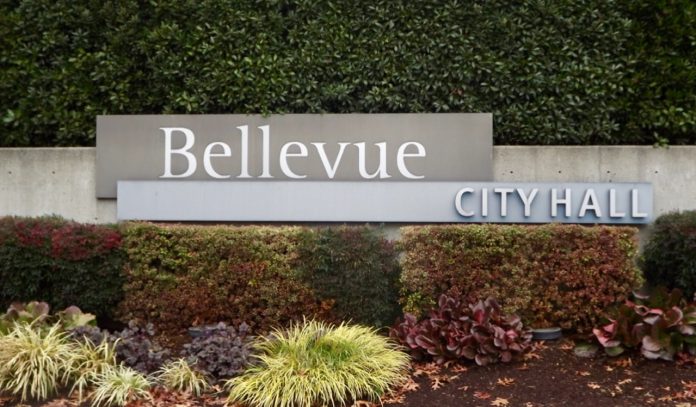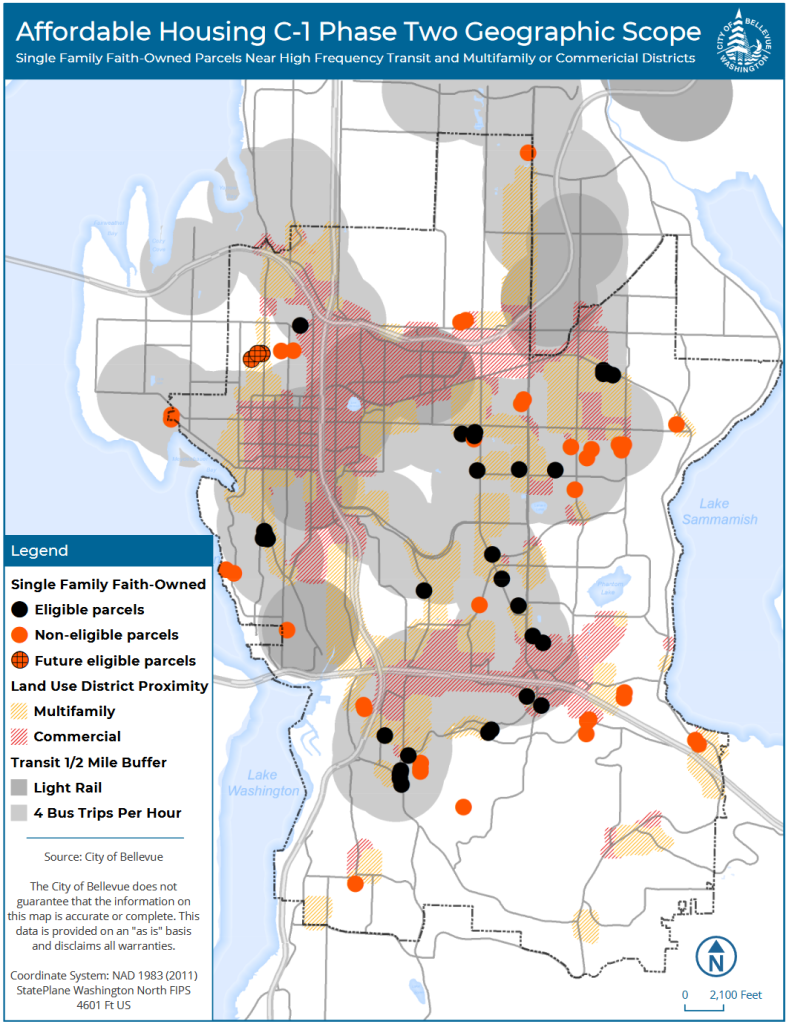
Work on the issue of affordable housing continues in Bellevue, as the City Council voted Monday evening to advance staff work on rezones for certain properties held by religious organizations. Additionally, the city authorized an agreement that will potentially help the city secure millions of dollars from lawsuits against opioid manufacturers, a small share of larger payout set to come to cities around the state.
Work Continues to Help Organizations Build More Affordable Housing on Religious Property
Implementation of Bellevue’s meager Affordable Housing Strategy has continued to chug along, but not all suggestions within the plan are created equal. Work around Strategy C-1 — increasing density on properties owned by faith-based organizations — is entering a new, meatier phase of implementation that could help increase Bellevue’s housing stock. At the time of the plan’s adoption, staff estimated that this action alone could facilitate as many as 1,000 new affordable units throughout the city.
Because land acquisition in suitable residential areas is often a difficulty for non-profits and other affordable housing builders, land owned by religious organizations presents an enticing option for partnerships. Through this approach, non-profits can find significant residential land, religious organizations can fulfill their philanthropic mission of helping their neighbors, and the community is treated to a significant increase of affordable housing. The State legislature recognized the benefit these partnerships can bring when they passed HB 1377 during the 2019 legislative session. The bill required cities planning under the Growth Management Act to offer density bonuses to affordable housing developers using land from religious organizations. Bellevue completed its work to comply with the law last year, when Council adopted a Land Use Code Amendment (LUCA) to provide a 50% density bonus for permanently-affordable housing on faith-owned properties.
However, the density bonus doesn’t really get at the crux of the city’s affordable housing strategy (nor is a 50% density bonus significantly helpful when a parcel of religious land is zoned for single-family). The initiation of Phase Two work, which would rezone certain religious properties to be multifamily, significantly increasing their density bonus, is the portion of the endeavor that will actually meaningfully add affordable housing in Bellevue. However, single-family religious properties that would be eligible for a rezone would still be subject to several exclusionary criteria. Only properties that are on an arterial, within a half-mile of frequent transit, and within 300 feet of a jurisdiction where multifamily or commercial uses are already permitted would be considered at this time.

Responding to a question from Councilmember Zahn on why a 300 foot proximity requirement to existing multifamily or commercial uses was included as a criterion, staff justified it as “the distance where [one] can visually see other development nearby that feels like it’s the same density”. In other words, staff wanted to limit visual impacts of multifamily developments on single-family neighborhoods. Similar sentiments were echoed by Councilmember Lee, who expressed concern that the system would be “abused” by faith-based organizations who would buy new land and have it converted into multifamily so that they could build permanently affordable housing near otherwise single-family neighborhoods.
Councilmember Zahn insisted that staff recalculate how many properties would be eligible for a rezone if the proximity requirement were increased to 600 or 1000 feet, and noted that there are architectural forms that can provide for density while fitting in with the character of single-family neighborhoods. Staff will return with that analysis during the summer, at the same time as they provide an update on the city’s next steps in the affordable housing arena.
Bellevue Agrees to Receive Payout from Lawsuit against Opioid Manufacturers
Nationwide, cities and states have chosen to sue the manufacturers of opioids for their contributions to the current nationwide opioid epidemic. In Washington’s lawsuit of the nation’s three largest opioid manufacturers, Attorney General Bob Ferguson alleged that these companies contributed to the illegal supply of opioids by failing to notify law enforcement of suspicious orders. Many Washington cities, including Seattle, have since filed their own lawsuits with similar allegations. Notably, Bellevue is the largest city in Washington that did not file its own lawsuit.
With Council’s vote to sign a statewide Memorandum of Understanding (MOU) on Monday evening, the city will stand to benefit from the lawsuits regardless. Some defendants have agreed in principle to settle the lawsuits, provided that a “global” settlement is reached with nearly all cities and counties in the state — including ones that did not file their own suit. The amount of funds allocated to a particular county is based upon its number of 1) opioid deaths, 2) people with opioid disorders, and 3) pills shipped, with city-level allocation dependent upon federal data of how cities have previously made opioid epidemic-related expenditures.
The MOU outlines that Bellevue would receive approximately 1.13% of any settlement funds, which would then need to be used for programs that help the treatment or prevention of opioid abuse. With the state’s pending receipt of $518 million in settlement funds, including $476 million to be earmarked for addressing the opioid epidemic, that means that Bellevue could receive approximately $5.37 million over the next 17 years. The city could choose to use that money itself or pool it with funds from other cities to address the crisis at a more regional level.
Staff shared before the vote that funds could be dispersed as soon as later this month, although a final date is to be determined. Bellevue did not make the full text of the MOU available in their meeting materials, but since 90% of Washington jurisdictions over 10,000 people must sign on before settlement funds can be distributed, other cities have had to make the same decision and therefore had copies to spare. Feel free to check out the full MOU text below.
Chris Randels is the founder and director of Complete Streets Bellevue, an advocacy organization looking to make it easier for people to get around Bellevue without a car. Chris lived in the Lake Hills neighborhood for nearly a decade and cares about reducing emissions and improving safety in the Eastside's largest city.

